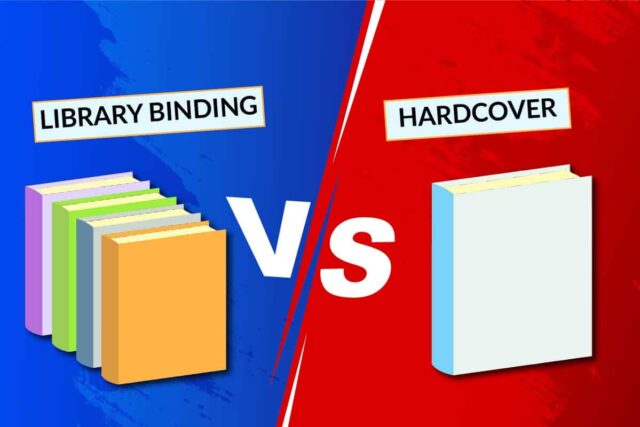The binding your book has is essential. When you want to sell your book, you have to choose the proper binding for it. Even when you want to buy a book, you still consider the binding. Your choice of binding is determined by what the book is for and how long you intend it to last.
To compare library binding vs. hardcover, you have to understand that they are both critical. Even though library binding and hardcover are different, they both add value to books.
What Is Library Binding?
Library binding is simply a strong binding that is used for books to make them last the test of time in a library. It also enables books to remain in order whether it is in frequent use or not.
Books have different values and differences in usage. This is why books that are in libraries undergo rebinding when they get damaged. Library binding is suitable for rebinding books, as well as helping books remain durable. It is ideal for books that are important for the information they contain and don’t value as objects.
Even though library binding is primarily for books kept in libraries, it is usually used on books meant for individuals.
Types Of Library Binding
Library binding is of two major types. These are the original and after-market.
Original library binding; involves the binding of books meant for library use. The book is bound to withstand stress and is different from other versions of the same book. For instance, the publisher of a law book sent a library-bound copy of the book to the public library.
After-market library binding; involves rebinding books that were formerly paperback or hardcover books for library use. For instance, if a book sent to the library is paperback, the library sends a library binder to get it library-bound.
What Is Hardcover?
Hardcover refers to the rigid covering of a book that protects the papers within. A hardcover book contains pages sewn together and glued to the spine (the book’s middle). Hardcover books have strong covers made of either fabric or leather-covered cardboard. They usually have thicker pages than a regular book, meaning the paper is of high quality.
Some hardcover books also have a dust jacket. The dust jacket is a removable paper that slides over the book’s cover and helps protect the book’s outer parts. Hardcover books that don’t come with dust jackets have their cover designs printed directly on the cover board.
What Are The Methods Of Library Binding?
Methods used for library binding includes;
Sewing through the fold;
involves attaching different signatures. A signature is a group of paper sheets folded in half and worked on as a unit. The signatures are connected one to another in succession to form the body of the book. And they are usually sewn through the fold by hand, with a needle and a thread. Furthermore, they are sewn by a machine, which has several needles and threads.
Books sewn through the fold have wide margins and can open flat. Pages cannot fall out unless they are torn.
Over-sewing;
in this method, loose pages of a book are sewn together to form the book’s body. And this can be done by hand or using a machine. Tiny vertical holes are pierced through each page’s far left side, and then the pages are sewn together to form the book’s body.
It’s a strong binding for books five inches thicker. Also, the margins of over-sewn books are lesser. And when the book gets opened, the pages will not lie flat.
Side sewing:
This method attaches loose pages by sewing the book’s entire body through the side, along the margin. And it’s done in a single pass and then sewn by a machine. Side-sewn books will not lie flat, though their pages are held together tightly.
What Are The Methods Of Hardcover Binding?
Case binding:
is a common method of hardcover binding. The pages are sewn together in signatures. The signatures are then glued together into a single body of a book. When the book gets opened, the pages will lay flat.
Double-fan adhesive binding:
This method uses polyvinyl acetate glue (PVA) instead of thread for the binding. It involves placing a small bead of glue on both of the pages after notching the spine’s edge. The book will have a wide margin and will open flat. Some types of paper do not hold adhesive well. And this will cause pages to come loose over time.
Over-sewing:
this method is the same as over-sewing in library binding.
Sewing through the fold (also known as Smyth sewing):
This is similar to sewing through the fold in library binding. Unlike over-sewing books sewn through the fold have wide margins and will open flat.
Materials Used For Library Binding
Covering materials:
The most common covering material used for library binding is called buckram. Buckram is a 100% cotton material and durable. It can be coated with acrylic.
Acrylic coatings are water-resistant:
They are also resistant to ultra-violet light, insects, and mold.
The cover boards:
the most preferred board for library binding is called Binder’s board. They have a high density. Others are laminated boards and fourdrinier boards.
Components Of A Hardcover
The Cover:
This is what gives hardcover books their durability. It consists of cardboard and a gloss or Binder’s board. A strong paperboard covered with buckram or other cloth, heavy paper, or leather gets used sometimes.
The Endsheet:
This refers to a white piece of paper glued to the inside of the book cover.
The Flyleaf:
The flyleaf is an empty page next to the end sheet. It is not glued to the book cover.
The Hinge:
The hinge is an area next to the spine that folds or bends when the book is opened. It allows the book to open freely without damaging the spine.
The Gutter:
The gutter is the space inside the page margins where the book is bound. Anything that appears in the gutter is often not visible. So, there has to be space to ensure everything is visible.
When To Choose Hardcover
If you are looking to choose a book cover, you should know that hardcover is best-used in some areas. For a book to be suitable for hardcover, it has to be above 30 pages. Also, it is ideal for books that you will keep for an extended period or memories, for example, art books and yearbooks.
It is also suitable for children’s books. Because it undergoes a high amount of stress and mishandling, it is a good choice for professional books such as medical books and self-published books.
How To Preserve Library Binding And Hardcover
- Store the book in a cool, dry, and clean environment. Do not expose the book to direct sunlight and reduce exposure to all light. If you are storing the books at home, use a room with minimal windows and low exposure to natural elements.
- Do not store the book near radiators and vents.
- Shelf books of similar sizes together, such that other books on both sides support a book’s cover. This also helps avoid indenting, which occurs when books of varying sizes are pressed on each other for a long time.
- Books with library binding are prone to collecting dust which can increase mold and lead to insect infestations. Dust the books regularly with a soft paintbrush or cloth in the opposite direction of the book spine.
- Keep books that are on shelves upright and not slanted. Please leave a little space in-between them to reduce pressure on the binding when removing them.
- You can protect the book further with a box.
- Conservation treatment can also help preserve books.
- Avoid stacking the books for a long time to reduce strain on the spine of the books.
- Don’t leave the books open, face-down for long to minimize strain on the spine.
- Books that are more than eighteen inches long or three inches deep (such as atlases) should lie flat. They can be stacked in groups of three on bookshelves or in containers.
- If you are storing books in boxes, make sure that the box will not allow UV light.
- Ensure that both hands are clean and dry before handling the books, so you don’t transfer the dirt to pages.
- When reading your books, it is important to limit how wide you open them to restrict their spine strain.
- Don’t use pens or markers on older books, so they don’t bleed to other pages. Use pencils instead, although note that all kinds of markings can devalue the books over time.
Differences Between Library Binding And Hardcover
It’s important to know that all library bindings are hardcover. But, not all hardcover is library binding.
Library binding is designed to withstand a lot of use and is generally more expensive than regular hardcover.
Library binding is not covered with a removable dust jacket. Sometimes, the cover looks heavy and unattractive. Dust jackets usually cover hardcover.
In terms of market price, library binding is more expensive than regular hardcover. The type of materials used and method of binding accounts for the price. This explains why library-bound copies of a book are few compared to the regular hardcover.
You May Like These Articles As Well:














